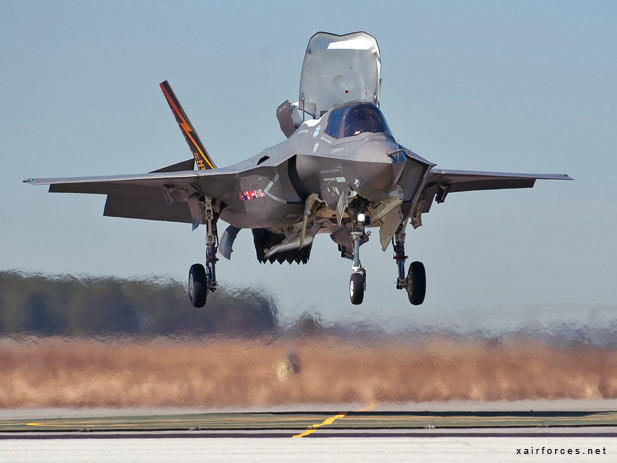
New Details on Troubled F-35 Fighter

Shortly before making a final push to ensure that the Marine version of the F-35 fighter was not canceled, the service’s commandant, Gen. James F. Amos, called in a former Marine corporal for a frank talk.
The onetime enlisted man, Robert J. Stevens, now heads Lockheed Martin, the giant contractor that has repeatedly run into difficulties in building the plane. And based in part on Mr. Stevens’s assurances that the problems could be fixed, General Amos was able to persuade top Pentagon officials to grant a reprieve — a two-year period to either save the Marine model or forget about it.
In announcing that decision this month, the defense secretary, Robert M. Gates, said that he was placing the Marine model — one of three versions of the radar-evading plane — on probation. And on Tuesday, the Pentagon’s program managers released new details about some of the parts problems and possible solutions, outlining the latest markers that could determine if, or when, the plane gets back on track.
The officials said some parts related to the plane’s high-powered propulsion system were being redesigned and a bulkhead in the fuselage reinforced. They added that a new lift fan that generates the powerful thrust needed for the plane to take off and land in short distances also had some heating issues and problems with vibrating doors.
But the officials said in a statement that the problems were “readily solvable through engineering adjustments.” Lockheed Martin officials said they were already making some of the changes.
Mr. Gates said on Jan. 6 that the Pentagon expected to spend an additional $4.6 billion to develop and test all the planes, bringing the total for the Air Force, Navy and Marine models to $51 billion by 2016.
The changes are the second significant revamping in less than a year for the program, the Pentagon’s most expensive, with projected costs of $382 billion for up to 2,456 planes. And as deficit-reduction efforts gain steam, the stakes continue to rise for everyone involved because the program represents a tempting pot of money if the military is forced to further tighten its spending.
The Marines feel particularly vulnerable. They passed up chances to buy other planes, betting heavily on the version of the F-35 that can take off and land almost like a helicopter and stay close to the front lines. It would replace their aging Harrier jets.
General Amos said recently that he had told program managers, “I intend to personally track the progress of our airplane over the next two years.” Given the problems, he added: “I will track every pound of weight growth, required engineering fixes and every test point completed.”
The F-35, also known as the Joint Strike Fighter, is likely to be Lockheed Martin’s largest military program for many years. But billions of dollars in revenue will also be delayed by the problems.
Mr. Gates said the Pentagon would push back production of 124 of the planes to pay for the corrective work and additional flight tests and to cover some of the reductions in future military spending that the White House recently demanded.
Program officials said on Tuesday that in addition to covering the extra costs on the F-35, delaying that many planes would also generate $6.9 billion in savings for the Pentagon.
Mr. Gates also has a lot on the line politically. He promoted the coming of the F-35 as a reason to cancel the highflying F-22 in 2009. But some Republicans are questioning that decision again, especially now that China seems to be progressing more quickly than expected on its own fighter with radar-evading capability.
In addition to the problems cited on Tuesday, a recent report by Pentagon testing officials raised questions about other systems on the F-35, including whether enough progress was being made on the millions of lines of software that control the plane.
Winslow T. Wheeler, a military analyst at the Center for Defense Information, a research group in Washington, said the Marine version was “so problematic that I cannot believe that the two-year probation was anything other than Gates kicking the can to his successor to kill the thing.”
But C. T. Burbage, a top Lockheed manager, said most of the difficulties stemmed from building a system that could lift more weight for every pound of thrust than any previous design.
He said flight tests showed that parts of the lift system were buffeted by more air turbulence than expected. He said the lift fan’s drive shaft also expanded more than expected from the intense heat, but the company had found ways to ease that problem.
Mr. Burbage also said Lockheed was concerned that the slowdown in production could complicate efforts to gain economies of scale and lower the cost of each plane. The Pentagon now estimates that each plane could cost $92 million, up from the $50 million projected in 2002.
SOURCE : WASHINGTON — By CHRISTOPHER DREW - The New York Times
Published: 25 January 2011
Photo: The Marines have bet heavily on a F-35 that can take off and land much like a helicopter. It would replace Harrier jets. (Lockheed Martin)
(6.02.2011)
|